Can Am Spyder Rs Roadster Bike
photography by Kevin Wing
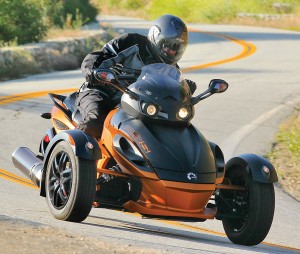
When Bombardier Recreational Products (BRP), the Canadian company best known for its Ski-Doo snowmobiles and Sea-Doo watercraft, introduced the Can-Am Spyder in 2008, I was intrigued. Seeing the wide, long, two-in-front/one-in-rear trike for the first time, I rocked back on my heels, stroked the hair on my chinny chin chin and wondered who it might appeal to, other than slednecks after the thaw. But now, having logged 4,000 miles aboard Can-Am Spyders, including the touring-spec RT and the sporty RS (Rider, March 2010, September 2008), having visited the factory in Quebec and talked to executives, and having seen reactions and heard opinions by motorcyclists and non-motorcyclists, I get it.
Just as trikes and sidecar rigs appeal to a small and specific group of motorcyclists, the Spyder fills a unique niche. BRP sought to build a machine that doesn't compete directly with the motorcycle establishment, a machine that would draw in new customers without preconceived notions about what the Spyder should be. According to Yves Leduc, BRP's general manager, the Spyder created a new category (BRP calls it a roadster), one that has enlarged the powersports pie instead of shifting customers from one slice to another. One-quarter of Spyder buyers had never set foot in a dealership before, and nearly as many are women, twice the percentage for motorcycle buyers. Demand for Spyders is high. Sales were up 20 percent last year, and dealers rarely deal on price. Even if a third wheel doesn't appeal to you, growth in the population of motorcycle sympathizers should. The more of us on the road, the better.
Advertisement
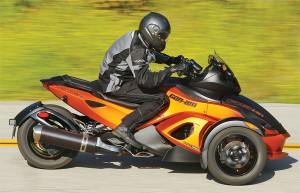
Three wheels, particularly the Y-configuration with two wheels in front, eliminate the biggest barrier for non-motorcyclists: having to balance and lean. (Conversely, not being able to lean is the biggest obstacle to acceptance among motorcyclists.) Trike riders appreciate the worry-free stability of three wheels, and the Spyder offers them a sophisticated, less costly alternative. The Spyder's Bosch-engineered Vehicle Stability System (VSS) goes a step further, combining stability control, traction control, anti-lock braking and dynamic power steering to keep all three wheels on the ground, gripping the road.
Relying on multiple ECUs and sensors, the system works well…almost too well. Riding fast in tight curves, right about the time the fun begins, the engine bogs down and the outside wheel's brake engages, thwarting a high-spirited corner exit. Sport riding on a Spyder requires a combination of athletic dexterity and subtle feel to get the most out of it before the VSS kicks in. Since the Spyder doesn't lean, you must position your body forward and to the inside of curves, steer smoothly and adjust throttle inputs to keep all the VSS sensors happy, sort of like finessing a pinball machine just shy of tilt. It can be quite a challenging workout, and loads of fun. Dial back the pace or stick to wide, graceful curves and you can forego the physical acrobatics, but some muscle will still be required to hold your line. As a three-track vehicle, the Spyder necessitates mindfulness of potholes and road debris, but the automotive-type tires provide loads of grip. Point it in the right direction and the Spyder will get you there, safely, regardless of what's on the road or what condition it's in.
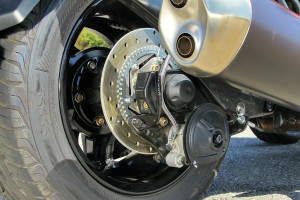
One option that makes the Spyder even less intimidating to operate is the SE5 (Semi-automatic Electronic 5-speed) transmission. Our 2011 Can-Am Spyder RS-S test unit included this $1,500 upgrade, which eliminates the foot shifter and clutch lever. To upshift, just tap a paddle on the left grip with your thumb. To downshift, tap another paddle with your left forefinger, or simply slow down—the transmission's centrifugal clutch downshifts automatically when engine speed falls below 2,500 rpm (1,500 rpm for first gear). In addition to five forward gears, there is a reverse gear, a handy feature for three-point turns (the Spyder has a wide turning radius) and navigating parking spaces. Along with the foot pedal-only operated brakes, which engage all three wheels simultaneously using Electronic Brake Distribution (80 percent front/20 percent rear under normal conditions), the SE5 transmission helps the Spyder work more like a car, and therefore seem more intuitive and appealing to anyone with a driver's license. It is unquestionably convenient and works flawlessly.
As a step up from the $16,499 Spyder RS, the $1,200-higher RS-S adds a go-faster look: a painted front spoiler and A-arm covers, carbon black aluminum parts, black six-spoke front wheels, a contrast-stitched seat and two-tone paint with special graphics. In addition to the stunning Alloy Orange Metallic/Matte Black you see here, the RS-S is also available in Pure Magnesium Metallic/Steel Black Metallic. Other than "bold new graphics," 2011 brought few changes to the Spyder RS line. A revised rubber mount system and second linkage rod reduce chassis vibration, and a new hood latch allows you to open the hood with one hand while the engine is running, but that's pretty much it.
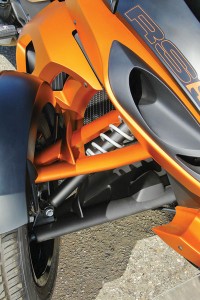
Positioned low in a Surrounding Spar Technology steel center-beam frame and hidden almost entirely behind fairing plastic is a 998cc, liquid-cooled, 60-degree V-twin built by Rotax, the Austrian engine manufacturer owned by BRP. A variation of this engine powered the Aprilia RSV Mille superbike, but in present form has a milder state of tune, with BRP claiming 106 horsepower and 77 lb-ft of torque. The engine revs quickly to its 10,000-rpm redline, and it emits a nice V-twin rumble and satisfying burble from the exhaust. Power reaches the rear wheel by way of a carbon reinforced belt, which should be adjusted every 6,000 miles. The four valves per cylinder are actuated by dual overhead cams, and their clearances must be checked every 12,000 miles. Oil changes are due every 3,000 miles, including engine oil and HCM (Hydraulic Control Module, on SE5-equipped models) oil filter replacement. A 10.8:1 compression ratio allows regular unleaded fuel, 6.6 gallons of which is stored in the underseat tank. Fuel economy is not the Spyder's strong suit. Weighing 800 pounds wet and punching a large hole in the atmosphere, our RS-S test unit burned fuel at an average rate of 26.1 mpg, almost exactly the same as we recorded in previous tests.
The Spyder's suspension is an auto/moto hybrid that is remarkably effective at keeping the wheels in contact with the ground. The front wheels attach to the chassis with double A-arms and an anti-roll bar, similar to those found on race cars, and each wheel has a preload-adjustable shock with 5.7 inches of travel. Each front wheel is able to absorb bumps independently to keep from upsetting the chassis, which is especially helpful if you accidentally run a wheel over a curb or off the edge of the road. The rear swingarm is suspended by a conventional preload-adjustable single shock, also with 5.7 inches of travel. Combined with the Vehicle Stability System and stout frame, the suspension helps the Spyder feel sure-footed at any speed.
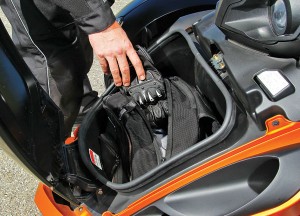
Starting and operating the Spyder requires unique rituals that, rather than serving as irritating differences from motorcycle routines, remind me that I'm not in Kansas anymore. Disengage the parking brake by stepping down on the pedal behind the left footpeg, press the Mode button (to acknowledge having read the safety card), press down on the brake pedal, then hit the starter. Tap the SE5 trigger to engage first gear and roll on the throttle to move forward. (If you're compelled to engage in hooliganism, BRP makes one allowance —with the handlebars straight, you can do a rolling, smoky burnout up to 35 mph. Woot!) Without rolling off the throttle, tapping the upshift paddle climbs through the gears with ease. The triple brakes are powerful, and there is no pulsing in the foot pedal when the ABS engages. When the key is turned off, a loud beeping noise serves as a reminder to engage the parking brake (at a stop, the SE5's clutch is always disengaged). Pushing in the key and turning it to the right unlocks the seat, allowing access to the underseat fuel filler; turning it to the left unlocks the front hood, allowing access to the waterproof, 44-liter (11.6 gallons) trunk, where the well-stocked toolkit is found.
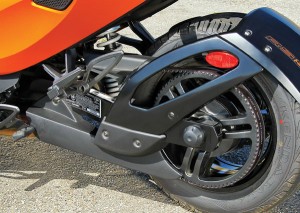
Though the footpegs are higher than I would prefer, especially on a machine that doesn't require cornering clearance, the Spyder RS-S has a comfortable, slightly forward sport-touring seating position. The wide, two-up saddle is comfortable, and at a height of 29 inches is easy to mount by almost anyone. My girlfriend Carrie found it easy to get on and off the Spyder, and she praised the seat. There are large grab handles, and holding on and adjusting body position gave her a great arm and core workout, but she missed feeling planted like she does when a motorcycle leans. Also, her right foot got hot from the exhaust pipe, which is just below the right passenger peg; I felt some heat off the left side, too. We were both rattled by the lack of wind protection, the stubby windscreen providing no bubble of still air. Over the past few years BRP has built up an impressive catalog of Spyder accessories, which includes passenger backrests, taller windscreens, wind deflectors, seats, lights, a 12V socket, saddlebags, luggage liners, custom parts and more. The Can-Am Spyder website allows you to build your own dream machine, with everything from picking model, color and transmission to outfitting it with accessories.
When I tested a Can-Am Spyder in 2008, pretty much everyone looked at me as if I were riding something out of Transformers. Even now, three years later, the Spyder still turns heads. The high curiosity factor isn't just about novelty. The Spyder's swooping design—BRP designers call it the "flowing edge"—inspires the same exciting feelings in others as I get when riding it. Long ago I learned to stop worrying and love the Spyder for what it is: fast, fun and unlike anything else on the road. If the idea of three wheels appeals to you, the Can-Am Spyder RS-S is one of a kind.
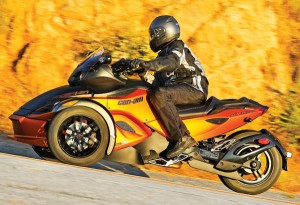
2011 Can-Am Spyder RS-S Specs
Base Price: $17,699
Price as Tested: $19,199 (SE5 transmission)
Warranty: 2 yrs., unltd. miles
Website: spyder.brp.com
Engine
Type: Liquid-cooled, transverse 60-degree V-twin
Displacement: 998cc
Bore x Stroke: 97.0 x 68.1mm
Compression Ratio: 10.8:1
Valve Train: DOHC, 4 valves per cyl.
Valve Adj. Interval: 12,000 miles
Fuel Delivery: Multi-point electronic fuel injection, 57mm throttle bodies x 2
Lubrication System: Dry sump w/ separate oil reservoir & oil cooler, 4.5-qt. cap.
Transmission: 5-speed electronic semi-automatic w/ reverse (as tested)
Final Drive: Belt
Electrical
Ignition: Electronic w/ dual output coil
Charging Output: 500 watts max.
Battery: 12V 21AH
Advertisement
Chassis
Frame: Surrounding Spar Technology steel center-beam
Wheelbase: 68.0 in.
Rake/Trail: NA
Seat Height: 29.0 in.
Suspension, Front: Double A-Arm w/ anti-roll bar & dual shocks, adj. for spring preload w/ 5.7-in. travel
Rear: Single shock, adj. for spring preload w/ 5.7-in. travel
Brakes, Front: 2 x 250mm discs w/ 4-piston calipers, ABS & EBD
Rear: 250mm disc w/ 1-piston caliper, ABS & EBD
Wheels, Front: Cast, 5.0 x 14 in.
Rear: Cast, 7.0 x 15 in.
Tires, Front: 165/65-R14
Rear: 225/50-R15
Wet Weight: 800 lbs.
Load Capacity: 388 lbs.
GVWR: 1,188 lbs.
Performance
Fuel Capacity: 6.6 gals., warning light on last 1.6 gals.
MPG: 87 PON min. (high/avg/low) 26.4/26.1/25.6
Estimated Range: 172 miles
Indicated rpm at 60 mph: 4,400
[This2011 Can-Am Spyder RS-S road test was originally published in the September 2011 issue ofRider magazine]
Can Am Spyder Rs Roadster Bike
Source: https://ridermagazine.com/2011/09/14/2011-can-am-spyder-rs-s-road-test/







Tidak ada komentar:
Posting Komentar